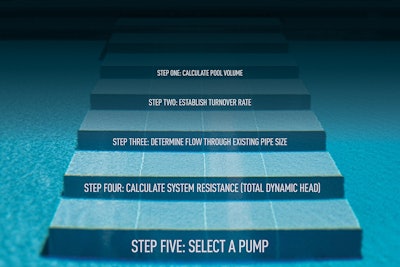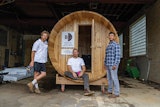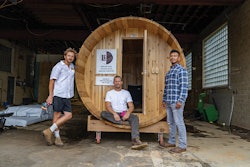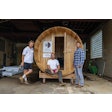
When the pool and spa industry learned that a residential swimming pool filtration pump was the second largest user of electrical power in a residential home, the need to sell horsepower was replaced with the need to save clients’ money.
A combination of local, state, and federal requirements adopted over the past 15 years has made variable-speed pool pumps the most popular type of pump sold in the market. With this increase in popularity, proper pump sizing is now more essential than ever to meet suction entrapment avoidance and energy efficiency requirements.
The Pool & Hot Tub Alliance (PHTA) Service Council recommends following these five steps to ensure the pool pumps you select for your projects meet or exceed industry standards and federal regulations.
STEP ONE: CALCULATE POOL VOLUME
Pools and spas are constructed in many sizes, shapes, and materials. The first thing to remember is that a cubic foot of water is equal to 7.48 gallons.
One formula is: Length x Width x Average Depth x 7.48 = Pool Volume (in gallons)
Keep in mind that when calculating pool gallons, the formula is different for round, oval, kidney-shaped, L-shaped, and freeform pools. In pools with various benches and steps, break the pool shape into manageable shapes and add up the cubic feet for each part of the pool.
In this calculation, Average Depth needs at least two depth markers. The more depth markers taken, the more accurate the measurement. Always divide by the number of depth markers taken. If two depth markers are taken, then divide by 2; if three depth markers are taken, then divide by 3; and so on. Average Depth works well with pools that have constant floor slopes or flat floors, but not so well with benches, ledges, and changes in floor slope. If working with the latter, break down the pool into manageable shapes.
STEP TWO: ESTABLISH TURNOVER RATE
Turnover rate is the time it takes to filter all of the water one time.
Local jurisdictions often have their own requirements for turnover rate. Always check your local codes for public pools, wading pools, hot tubs, and spas.
The International Swimming Pool and Spa Code (ISPSC) turnover rate in hours, as found in Section 407.2, is: V ÷ TR in hours ÷ 60 min/hr = FR in gpm, where V is the pool volume in gallons, TR is the turnover rate, 60 is the conversion for minutes per hour, and FR is the flow rate of the pump in gpm.
The pool and spa industry uses a process called “consecutive dilution.” If we turn a body of water every 6 hours (4 times in 24 hours), we achieve 95% consecutive dilution. Refer to ANSI/PHTA/ICC-2 2023 American National Standard for Public Pool and Spa Operations and Maintenance, Sections 9.1 and 13.1, for more details.
For Category Class A, B, and C swimming pools, the turnover period is: 1 1⁄2 x Average Depth (ft) = Hours of Turnover, to a maximum of 6 hours. Provisions in the federal energy code prohibit turnover rates faster than 6 hours for residential pools but flow rates must not be less than 36 gpm. So, a 5-hour turnover would be prohibited but a 7- or 8-hour turnover is allowed. Under new provisions of the PHTA-5 Standard for Residential Inground Swimming Pools that will be released in the coming year, the maximum would be 12 hours. For Category Wading Pools, the turnover period is 1 hour.
For Category Public Spas, refer to ANSI/PHTA/ICC-2 2023 American National Standard for Public Pool and Spa Operations and Maintenance.
STEP THREE: DETERMINE FLOW THROUGH EXISTING PIPE SIZE
We are now ready to establish how much water can flow through the existing pipe size safely and efficiently. For existing pools, we must verify what size pipe the pool is plumbed with. The velocity at which water flows through a pipe is measured in feet per second (FPS). Water flowing at excessive speeds dramatically increases the friction loss or resistance.
The ISPSC for velocity in pool plumbing allows 8 FPS on the suction plumbing and 8 FPS on the discharge for safety. ANSI/PHTA/ICC-15 2021 American National Standard for Residential Swimming Pool and Spa Energy Efficiency allows 6 FPS on the suction plumbing and 8 FPS on the discharge plumbing for energy efficiency. GENESIS, a part of PHTA that serves as a premier education program for pool professionals, recommends 5 FPS suction plumbing and 5 FPS on the discharge for design accepting slightly higher velocities in existing systems.
Keep in mind that you need some flexibility to adjust flows in the field, and you cannot calculate the head loss that accurately, especially when the head loss across the filter is variable.
Daniel Bernoulli’s principle gives us two important considerations in pool hydraulics and mechanics:
- In a closed system, like a swimming pool circulation system, the flow rate is constant. The velocity is not, but the flow rate is. If the pump is moving 125 gpm, the pipe, no matter the size, is moving 125 gpm.
- The faster the water is moving, the lower the static pressure from that water.
The recommended design flow for both safety and efficiency through 1 1/2-inch pipe at 6 FPS is 37 gpm. As an example:
TurnoverRate=V÷FR÷60min/hr= TR in hours
Turnover Rate = 27,275 gal ÷ 37 gpm ÷ 60 min/hr = 12.29 hours
The 36 gpm is the minimum flow rate to be considered. The 6-hour turnover is still the required fastest turnover, but if that calculation yields a flow rate of, say, 24 gpm, you would use 36 gpm as the minimum design flow rate.
STEP FOUR: CALCULATE SYSTEM RESISTANCE (TOTAL DYNAMIC HEAD)
How can we measure this resistance when the plumbing lines and fittings are, for the most part, buried underground? Total dynamic head (TDH) is a measure of the total losses in the pool circulation system. TDH can be measured by any operation system by using the pump vacuum and pressure gauges. The pressure side head and the vacuum side head added together is a measure of the actual operating TDH of the system.
According to ANSI/PHTA/ICC-7 2020 American National Standard for Suction Entrapment Avoidance In Swimming Pools, Wading Pools, Spas, Hot Tubs and Catch Basins, TDH is the sum of the difference in elevation between the source and destination and the friction losses in a piping system. It has units of pressure (such as PSI) but is commonly given in feet of head. Since friction losses depend on flow rate, the TDH must be specified for a particular flow rate.
The calculation is: Pump head + Vacuum side head = Total Dynamic Head (TDH)
Or, more precisely: (PSI x 2.31= Feet of Pump head) + (Inches of mercury x 1.133 = Feet of Vacuum side head) = Total Dynamic Head
Install a vacuum gauge into the drain plug on the pump strainer housing. This is the vacuum side of the system. Then, install a pressure gauge on the volute housing of the pump. This is the pressure side of the system. Make sure the filter is clean before taking any measurements.
Refer to ANSI/PHTA/ICC-7 2020 Section 4.4.5.1 for more information. Additionally, ISPSC 2021 Section 311 covers requirements for circulation systems for all pools and spas other than portable residential spas, onground storable pools, and portable residential exercise spas.
STEP FIVE: SELECT A PUMP
Each manufacturer creates a certified pump curve for each model it sells. Pump curves show the relationship between the head on the vertical axis and flow rate on the horizontal axis for that model of pump and will always start high on the left and drop to the right.
In the U.S., the vertical axis is in feet of head, and the horizontal axis is in gallons per minute. Read carefully!
The flatness of the left side of the curve indicates that just a small increase in TDH due to errors in our calculation will have a devastating effect on the gpm. Where the curve meets the left scale is called the shut off head. If the resistance to flow is this high, the pump will spin but no flow will result.
The right side of the curve is steeper, meaning a more significant change in head is necessary to change the discharge gpm.
Where the system curve crosses the manufacturer’s pump curve is the operational point for that particular pump.
Obviously, we would want a system curve that would go upward and to the right through the heart of the efficiency curves. In smaller pumps, like those used in residential pools and certain commercial pumps, such as Pentairs’s EQ series composite body pumps, the pumps have a fixed diameter impeller, and the pool designer is forced to find the pump that best suits his or her needs, and then correct the entire pipe network for the actual and not the intended design flow or, alternatively, use variable-speed pumps!
The head losses in a system are dependent on pipe geometry and restrictions to flow, but head losses are likewise dependent on flow rate. Given a particular system of pipes and valves, the calculated TDH will vary with the flow rate. The higher the flow, the higher the head loss or TDH. The starting point of the curve is zero flow/ zero head loss since there is no head loss until the water moves. When the flow is zero, the head loss is also zero. When the flow is maximum, the head loss is maximum as well. This curve is unique to any particular pump system. Change anything in the system, such as adding bends or valves, and the curve will change as well. We will have to calculate the system curve points for at least three different flows to plot a curve.
In looking at a specific example for a specific pump (the Pentair IntelliFlow3 1.5HP in this case), taking the calculated total dynamic head of the system from the pump, we would like to replace vacuum and pressure gauge using the ANSI-7 2020 4.4.5.1 maximum system flow rate unsecured controlled system residential and public pool method. We get 81.63 actual operating total for the head of the system. Looking back to our turnover calculation, from the ISPSC Swimming Pool Category A, B, and C Pools turnover, 1 1⁄2 x Average Depth = Hours of Turnover Required, to a maximum of six hours.
V is the pool volume (in gallons), FR is the flow rate of the pump in (gallons per minute), 60 is the conversion for minutes per hour, and TR is the turnover rate.
Flow rate = V÷TR in hours ÷ 60 min/hr = FR in gpm
27,275 gal ÷ 6hr ÷ 60min/hr = 75.76 gpm
When looking at the corresponding Pentair pump performance curve for the IntelloFlo3 1.5HP pump, the plotting of the 81 TDH vertical axis and 75 gpm horizontal access shows the IntelliFlo 3 1.5HP plot point is above the 100% or 3450 RPMs performance curves. The plot point of the 81 TDH vertical access and 75 gpm horizontal axis on the IntelliFlo3 3.0HP, however, sits right at the 100% or 3450 RPMs performance curve. The IntelliFlo3 3.0HP will be the correct pump that we will be selecting.
By following these five steps and performing correct calculations, you will be able to better serve your clients and ensure your pool and spa projects meet federal, state, and local standards and regulations.
For more details, charts, and example calculations, please read the full article from the PHTA Service Council on phta.org.
This article first appeared in the January 2025 issue of AQUA Magazine — the top resource for retailers, builders and service pros in the pool and spa industry. Subscriptions to the print magazine are free to all industry professionals. Click here to subscribe.











































